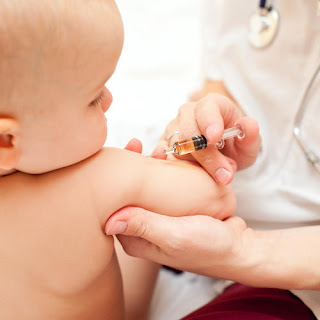Tetanus, also
called lockjaw, is a serious infection caused by Clostridium
tetani; this bacterium produces a toxin that affects the brain and
nervous system, leading to stiffness in the muscles.
Here are some key points about tetanus
- Tetanus is caused by the Clostridium tetani bacterium
- The early symptoms of tetanus include diarrhea, fever, and headache
- Earlier diagnosis predicts better outcomes
Causes of tetanus
Tetanus is caused by the Clostridium
tetani bacterium. lostridium tetani spores
are able to survive for a long time outside of the body. They are most commonly
found in animal manure and contaminated soil, but may exist virtually anywhere.
When Clostridium tetani enter
the body, they multiply rapidly and release tetanospasmin, a neurotoxin. When
tetanospasmin enters the bloodstream, it rapidly spreads around the body,
causing tetanus symptoms. Tetanospasmin interferes with the signals traveling from the brain to the nerves in the spinal cord, and then on to the muscles, causing muscle spasms and stiffness.
Puncture wounds - Clostridium tetani enters the body mainly through skin lesions (skin cut or puncture wound). Thoroughly cleaning any cut helps prevent an infection from developing.
Common ways of contracting tetanus
- Wounds that have been contaminated with saliva or feces
- Burns
- Crush injuries
- Wounds that include necrotic (dead) tissue
- Puncture wounds
Rare ways of contracting tetanus
- Surgical procedures
- Superficial wounds
- Insect bites
- Compound fractures
- Intravenous drug use
- Injections into the muscle (intramuscular)
- Dental infections
Symptoms of tetanus
Tetanus symptoms usually emerge about 7-10 days after initial infection; however, this can vary from 4 days to about 3 weeks, and, in some cases, it may take months.Most patients with tetanus will also have the following symptoms:
- Bloody stools (feces)
- Diarrhea
- Fever
- Headache
- Sensitivity to touch
- Sore throat
- Sweating
- Tachycardia (rapid heartbeat)
Complications
If the patient does not receive treatment, the risk of life-threatening complications is higher - mortality rates vary from 40-76 percent - symptoms may include:- Fractures - sometimes, in severe cases, the muscle spasms and convulsions may lead to bone fractures.
- Aspiration pneumonia - if secretions or contents of the stomach are inhaled, a lower respiratory tract infection can develop, leading to pneumonia.
- Laryngospasm - the larynx (voice box) goes into a spasm which can last up to a minute and cause breathing difficulties. In severe cases, the patient can suffocate.
- Tetanic seizures - if infection spreads to the brain, the patient can have epileptic-like fits (seizures).
- Pulmonary embolism - a blood vessel in the lung can become blocked and affect breathing and circulation. The patient will urgently need oxygen therapy and anti-clotting medication.
- Severe kidney failure (acute renal failure) - severe muscle spasms can result in the destruction of skeletal muscle which can cause myoglobin - a muscle protein - to leak into the urine. This can cause acute renal failure (severe kidney failure).
Prevention of tetanus
Most cases of tetanus occur in people who have never been immunized (never had the vaccine), or who did not have a booster shot within the preceding decade.The tetanus vaccine
The tetanus vaccine is routinely given to children as part of the DTaP (diphtheria and tetanus toxoids and acellular pertussis) shot. The DTaP vaccine consists of five shots, usually given in the arm or thigh of children when they are aged:- 2 months
- 4 months
- 6 months
- 15 - 18 months
- 4 - 6 years
Treatments for tetanus
Any cut or wound must be thoroughly cleaned to prevent infection. A
tetanus-prone wound should be treated by a medical professional immediately. What is a tetanus-prone wound? According to the National Health Service (NHS), United Kingdom, it is defined as:
- A wound or burn that requires surgical intervention that is delayed for over 6 hours
- A wound or burn that has a considerable amount of removed (devitalized) tissue
- Any puncture-type injury that has been in contact with manure or soil
- Serious fractures where the bone is exposed to infection (compound fractures)
- Wounds or burns in patients with systemic sepsis
TIG is just short-term and does not replace the long-term effects of vaccination. Experts say that TIG injections can be safely administered to pregnant and breastfeeding mothers.
Antibiotics - doctors may prescribe penicillin or metronidazole for tetanus treatment. These antibiotics prevent the bacterium from multiplying and producing the neurotoxin that causes muscle spasms and stiffness. Patients who are allergic to penicillin or metronidazole may be given tetracycline instead.
In treating muscle spasms and stiffness, patients may be prescribed:
- Anticonvulsants - such as diazepam (Valium) - relaxes the muscles to prevent spasms, reduces anxiety, and works as a sedative.
- Muscle relaxants - such as baclofen - suppresses nerve signals from the brain to the spinal cord, resulting in less muscle tension.
- Neuromuscular blocking agents - these medications block the signals from nerves to muscle fibers and are useful in controlling muscle spasms. They include pancuronium and vecuronium.
Surgery
If the doctor thinks the tetanus prone wound is very large, they may surgically remove as much of the damaged and infected muscle as possible (debridement).Debridement is the act of removing dead or contaminated tissue, or foreign material. In the case of a tetanus-prone wound, the foreign material may be dirt or manure.









No comments:
Post a Comment